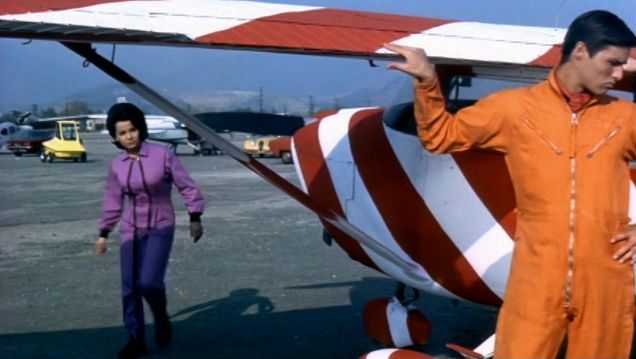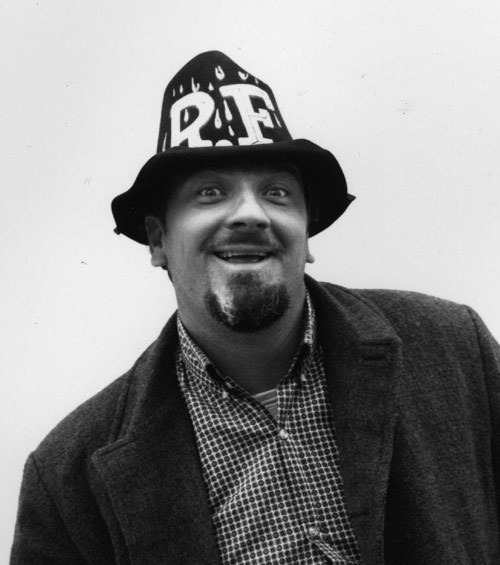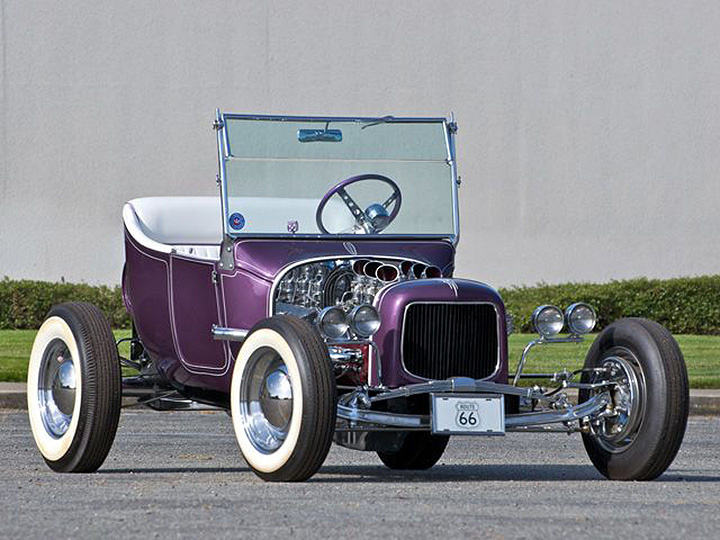"...expect criticism; if you can't do it get help; you don't need fancy tools or a fancy garage; and if you fulfill your duty Heavenly Father will bless you in what you do."
__________________________________________________________________________

Do you see that little yellow vehicle in the background behind Annette Funicello? It really deserved to be the star of Beach Blanket Bingo, probably the best of those terrible mid-sixties beach movies. That's just my personal opinion, of course, but for all of the songs, surfboards and bikinis in that film, it was that stray bit of decoration that remained in my memory and imagination. [Well, maybe Donna Michelle was a close second.]

The Surfite in full glory at a recent auto show.
The car was "The Surfite" and was one of many, many creations, automotive and otherwise, of Ed "Big Daddy" Roth, one of the most original, prolific, and ignored American artists of the post-WWII period. I knew of the cars not because they would ever be seen on the east side of Cleveland, but because they were well represented in the modeling aisle of my local Woolworth's.
My fellow juvenile delinquents and I could never get enough of the models of cars designed by Big Daddy and news of a new product on the five and dime shelves would make the rounds of recess at Lincoln Elementary School with all of us attempting to be the first to score fifteen cents for the model and another ten for the custom paint set. Yes, life was that exciting in Ohio in the early '60's.
About five years later, when I discovered surfing, I was amazed to discover that Big Daddy was an influence in the design of what was becoming called the "surf lifestyle". When I was older still, and the owner of a battered BMW R100 motorcycle, I discovered that Roth was still an influence in the burgeoning bike customization industry. I've studied everyone from Xenokrates of Sicyon to Salvador Dali, even married an art history major, and can't recall any artist having such a trans-cultural influence through graphic, commercial, animated, and industrial art.
Ed Roth, like his school of art, was born in L.A. County. He lived through the period when his city transformed from orange groves and farmland to the entertainment capital of the world with that urge to entertain influencing all other endeavors. For some reason it also became, by the late 1950's, the car and motorcycle customization capital of the world.
Roth originated automobile pin-striping at his art/auto body/t-shirt shop in 1959 and financed his operation mainly by creating one-of-a-kind designs airbrushed onto t-shirts and sold at various hot rod shows. The designs were bizarre, sometimes horrifying, and certainly different from anything else that was on offer in the days of Ozzie and Harriet. It's no wonder that the burgeoning car/cycle crowd found them evocative. As the dominant animal in southern California was Mickey Mouse, an icon loathed by most normal people, Roth created a dark alternative.
Behold, the Rat Fink:

Whether or not the reader has seen this particular icon, it is the spirit animal of an entire school of art that has influenced almost everything we have seen during the last fifty years. Certainly, it was ubiquitous in youth culture as it was found on t-shirts, motorcycle helmets, car models, shift knobs, guitars, coin banks, barware, decals, and bobble head dolls. In 6th Grade, I had a collection of Rat Fink erasers for my #2 pencils.

By the mid-20th century, both DuPont and Owens-Corning had perfected the combination of glass strands, silica, and polyester resin to create what we now recognize as fiberglass. With this medium, car bodies could be shaped in ways not possible with sheet metal, provide for a lighter overall weight, thus boosting horsepower, yet retain the strength necessary to carry the chassis. When Roth realized what this newest form of plastic could do, he was limited only by his imagination; if it had any limits, that is.
While I could describe the cars that Roth would create, in forms and styles never before seen, it's far easier to show them.
Tweedy Pie, 1964

Road Agent, 1965

Druid Princess, 1966

Beatnik Bandit, 1960

Mysterion, 1963

Orbitron, 1964

Tellingly, the fate of the Orbitron sums up the reality of Roth's world. It was originally sold for $750 [yes, that's right] to another KK customizer who, in turn, sold it to a collector in Texas, who sold it to a carnival owner in Chihuahua, Mexico. By 1991, the Orbitron had disappeared. Although, there were rumors....
Following up on those rumors in 2007, a professional car finder [that's an actual job] discovered the Orbitron, or what was left of it, being used as a trash trailer for the owner of an...ahem..."adult lifestyle" store in Juarez. After considerable negotiation, the hulk was brought back to southern California and recently had its full restoration completed.
Much like the Orbitron, Kustom Kulture and the works of Roth have never quite disappeared, although they have morphed into other media. On any given evening, cable TV is filled with "reality" shows about customizing cars and motorcycles, skateboard and surfing periodicals are mostly ads for the ephemera of the sports rather than athletic pursuit, and colorful t-shirts sporting characters and ironic statements are the norm even in Brooklyn in winter. What was once a sub-genre lost in its own orbit has since managed to influence the mainstream without having given up its edginess.
A lot of that spirit of defiance can be traced to Roth. Once, when on his way to some car show in some middle-of-nowhere location, driving himself in one of his less dramatic creations, he pulled to the side of the road for the evening, sleeping in the car. As he was 6'4", his bare feet were left sticking out the window and, when a fan with a camera recognized the car and took a photo of the scene, the Revell model company, that paid Roth a considerable sum to copy his cars, suggested that he neaten up his image. He did so, not by adopting a Brooks Brothers suit, but by buying used white tie and tails, complete with top hat and monocle. Like the Rat Fink, that look became his signature and a familiar sight at auto shows. Big Daddy's life had now become his art.
Roth would continue to stoke his brand, licensing the Rat Fink and related products, selling a line of metal flake auto paint under his name, and making the rounds of auto shows signing autographs and delighting fans. His wild nature was mollified in his later years as he became a Mormon and dedicated the remainder of his life serving his church and enabling good works. He died shortly before his 70th birthday in 2001.
Ed Roth captured the attention of Tom Wolfe in his article "The Kandy-Kolored Tangerine-Flake Streamline Baby", is the subject of numerous art and automotive books, at least one well-received documentary, "Tales of the Rat Fink", and maintains a popular online presence.
Ed Roth, like his school of art, was born in L.A. County. He lived through the period when his city transformed from orange groves and farmland to the entertainment capital of the world with that urge to entertain influencing all other endeavors. For some reason it also became, by the late 1950's, the car and motorcycle customization capital of the world.
Roth originated automobile pin-striping at his art/auto body/t-shirt shop in 1959 and financed his operation mainly by creating one-of-a-kind designs airbrushed onto t-shirts and sold at various hot rod shows. The designs were bizarre, sometimes horrifying, and certainly different from anything else that was on offer in the days of Ozzie and Harriet. It's no wonder that the burgeoning car/cycle crowd found them evocative. As the dominant animal in southern California was Mickey Mouse, an icon loathed by most normal people, Roth created a dark alternative.
Behold, the Rat Fink:

Whether or not the reader has seen this particular icon, it is the spirit animal of an entire school of art that has influenced almost everything we have seen during the last fifty years. Certainly, it was ubiquitous in youth culture as it was found on t-shirts, motorcycle helmets, car models, shift knobs, guitars, coin banks, barware, decals, and bobble head dolls. In 6th Grade, I had a collection of Rat Fink erasers for my #2 pencils.

And hats, too. Especially the "hillbilly crash helmet" modeled above by its maker.
Along with other tactile artists such as Dean Jeffries [who created, among other works, the original dune buggy and the car driven by The Monkees on their eponymous TV show], graphic artist Von Dutch, George and Sam Barris [of the original Bat-mobile], and other car, motorcycle, and guitar customizers, tattoo artists, cartoonists, fashion designers, and musicians, Roth and his cadre were the representatives of what is now known as Kustom Kulture.
From a popular information site:
Kustom Kulture is usually identified with the greasers of the 1950s, the drag racers of the 1960s, and the lowriders of the 1970s. Other subcultures that have had an influence on Kustom Kulture are the Skinheads, mods and rockers of the 1960s, the punk rockers of the 1970s, the metal and rockabilly music, along with the scooterboys of the 1980s, and psychobilly of the 1990s. Each separate culture has added their own customizations to the cars, their own fashions, influenced the music, and added their own ideas of what is cool, of what is acceptable, and what is not. Everything from wild pinstriped paintjobs, to choptop Mercurys, to custom Harley-Davidson and Triumph Motorcycles, to metal-flake and black primer paint jobs, along with music, cartoons, and monster movies have had an impact on what defines anyone and anything who is part of this automobile subculture.While an artist, t-shirt designer, musician [his band was "Mr. Gasser & the Weirdos"] and fashion icon, it was with cars that Roth made his biggest impact. Originally, Big Daddy was the guy who simply put pinstripes on cars, which he then expanded to custom colors and media, making the metal flake finish popular in the custom world. And then came the most wonderful construction material of all, the one that transformed surfboard shaping, watercraft design, and auto body fabrication.
By the mid-20th century, both DuPont and Owens-Corning had perfected the combination of glass strands, silica, and polyester resin to create what we now recognize as fiberglass. With this medium, car bodies could be shaped in ways not possible with sheet metal, provide for a lighter overall weight, thus boosting horsepower, yet retain the strength necessary to carry the chassis. When Roth realized what this newest form of plastic could do, he was limited only by his imagination; if it had any limits, that is.
While I could describe the cars that Roth would create, in forms and styles never before seen, it's far easier to show them.
Tweedy Pie, 1964

Road Agent, 1965

Druid Princess, 1966

Beatnik Bandit, 1960

Mysterion, 1963

Orbitron, 1964

Tellingly, the fate of the Orbitron sums up the reality of Roth's world. It was originally sold for $750 [yes, that's right] to another KK customizer who, in turn, sold it to a collector in Texas, who sold it to a carnival owner in Chihuahua, Mexico. By 1991, the Orbitron had disappeared. Although, there were rumors....
Following up on those rumors in 2007, a professional car finder [that's an actual job] discovered the Orbitron, or what was left of it, being used as a trash trailer for the owner of an...ahem..."adult lifestyle" store in Juarez. After considerable negotiation, the hulk was brought back to southern California and recently had its full restoration completed.
Much like the Orbitron, Kustom Kulture and the works of Roth have never quite disappeared, although they have morphed into other media. On any given evening, cable TV is filled with "reality" shows about customizing cars and motorcycles, skateboard and surfing periodicals are mostly ads for the ephemera of the sports rather than athletic pursuit, and colorful t-shirts sporting characters and ironic statements are the norm even in Brooklyn in winter. What was once a sub-genre lost in its own orbit has since managed to influence the mainstream without having given up its edginess.
A lot of that spirit of defiance can be traced to Roth. Once, when on his way to some car show in some middle-of-nowhere location, driving himself in one of his less dramatic creations, he pulled to the side of the road for the evening, sleeping in the car. As he was 6'4", his bare feet were left sticking out the window and, when a fan with a camera recognized the car and took a photo of the scene, the Revell model company, that paid Roth a considerable sum to copy his cars, suggested that he neaten up his image. He did so, not by adopting a Brooks Brothers suit, but by buying used white tie and tails, complete with top hat and monocle. Like the Rat Fink, that look became his signature and a familiar sight at auto shows. Big Daddy's life had now become his art.
Roth would continue to stoke his brand, licensing the Rat Fink and related products, selling a line of metal flake auto paint under his name, and making the rounds of auto shows signing autographs and delighting fans. His wild nature was mollified in his later years as he became a Mormon and dedicated the remainder of his life serving his church and enabling good works. He died shortly before his 70th birthday in 2001.
Ed Roth captured the attention of Tom Wolfe in his article "The Kandy-Kolored Tangerine-Flake Streamline Baby", is the subject of numerous art and automotive books, at least one well-received documentary, "Tales of the Rat Fink", and maintains a popular online presence.


